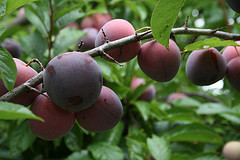Plums
| Infobox on Plums | |
|---|---|
| Example of Plums |  |
| Freshness facts | |
| Optimum carrying temperature | 0°C (cultivar dependent) |
| Highest freezing point | -1°C to -2°C (depending on SSC = Soluble Solids Content) |
| Acceptable product temp. at loading into containers | Max. 2°C above carrying temperature |
| Optimum humidity | 90%-95% |
| Ventilation setting for containers | 25 m³/hr |
| Storage life | 3-6 weeks |
| Climacteric / non-climacteric | Climacteric |
| Ethylene production | Medium |
| Ethylene sensitivity | High |
| Modified / controlled atmosphere | 0%-5% CO2; 1%-2% O2 |
| Potential benefits | Increased CO; moderate to good Reduced O2; good |
| Availability | |
| South America South Africa |
December - February January - April |
Plums
Contents
Harvesting and handling
In most of the plum cultivars, harvest date is determined by skin colour changes that are described for each cultivar. Measurement of fruit firmness is recommended for plum cultivars where skin ground colour is masked by full red or dark colour development before maturation.
Plums are less susceptible to bruising than most peach and nectarine cultivars at comparable firmness.
Cooling and storage
Plums are climacteric (stone-)fruit, and, provided they are sufficiently mature when picked, can undergo softening and sweetening after harvest. Rapid cooling after harvest to temperatures below 4ºC (preferably 0ºC) is important to retard respiratory activity, ripening and decay. At 0ºC and 90%-95% relative humidity, typical storage periods for plums are 3-6 weeks; there being a wide range amongst cultivars (and growing seasons/periods). Postharvest life varies among cultivars and it is strongly affected by temperature management.
Internal breakdown occurs due to problems in the postharvest handling. At temperatures between 2° and 7°C, the internal breakdown develops rapidly and is most severe at 5°C. Unfortunately the temperature of most domestic refrigerators and mixed produce containers and many cool rooms falls right in the middle of this range (4°-5°C). At temperatures below 2° and above the freezing point of the fruit (about -1°C) the rate of development of IB is much slower, and so this is the recommended storage temperature of stone fruit. Even at the recommended storage temperatures the fruit does not have an indefinite shelf life. Internal breakdown will still begin to develop and can become a problem if fruit is stored for too long, however other factors like softening, lack of flavour and decay are usually then responsible for the end of shelf life of the fruit.
It may be argued that holding fruit temperatures above the 'Danger Zone' is easier to achieve and would avoid the problem of internal breakdown. It must be remembered that internal breakdown is not the only reason fruit may become unacceptable for sale. At storage temperatures above 10°C, internal breakdown will not occur in the fruit, but other quality parameters will start to be affected. At higher temperatures, weight loss leading to shrivelling, rots and moulds and general 'ageing' of the fruit will occur more rapidly. The 0°-2°C temperature zone is the ideal handling system to minimise the risk of all potential problems and best maintain quality. Where the period from harvest to reaching the consumer is short there is some justification for maintaining temperature above the 'Danger Zone'. However, when that period is extending beyond a couple of days, product quality will begin to suffer.
South African research workers (PPECB) state that most plums cultivars are susceptible to flesh breakdown if exposed to low temperatures (minus 0,5°C) for longer than about ten (10) days. Research conducted over many seasons led to the development of the so-called dual temperature storage regime, in which the fruit is initially stored at minus 0,5°C for ten (10) days to derive the maximum benefits of reduced ripening and deterioration rates, followed by an increase of temperature to 7,5°C. This regime has generally proven to be of value, although there have been seasons in which it has not worked satisfactorily.
The exact application of dual temperature shipping sometimes varies because of different cultivar reaction, maturity, length of voyage and market requirements. This means, in effect, that PPECB monitors delivery- (DAT) and return air temperatures (RAT) in the vessel, and adjusts the regime accordingly, after consultation with the exporter.
The intention of the "third phase" of -0,5°C following the period at +7,5°C is not to re-cool the plums, but only to stabilise the respiration heat that developed during the period at +7,5°C. This final period at -0,5°C may not reduce the plum pulp temperature at all, but may reduce the return air temperature by a few degrees. Internal Breakdown or Chilling Injury is characterised by flesh translucency, flesh internal browning, flesh mealiness, flesh bleeding, failure to ripen and flavour loss. These symptoms develop in plums during ripening after a cold storage period. Chilling injury is a concern with most plum cultivars. Late plum cultivars develop lack of juiciness in addition to these symptoms.
Mixed loads
Plums should not be shipped with ethylene-generating commodities.
Cautions
O2 below 1% can cause off-flavours and failure to ripen. CO2 greater than 5% for longer than one month may cause flesh browning in some cultivars. There has been limited use of CA for storage of some cultivars which are not susceptible to internal breakdown.
Storage disorders
Alternaria rot, Anthracnose, Bacterial spot, Blue mould, Brown rot, Bruising, Cladosporium rot, Cracking, Freezing injury, Grey mould rot, Insect damage, Internal breakdown, Mosaic virus, Powdery mildew, Pustular spot, Rhizopus rot, Rust, Scab, Sour rot.











